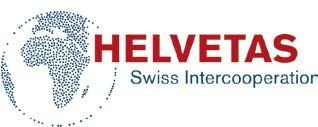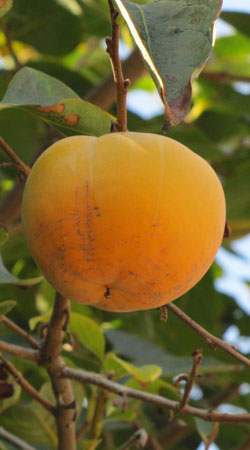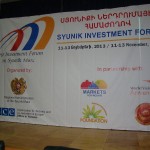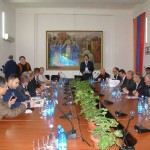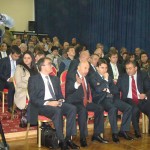Syunik Region historically was one of the most industrially developed areas of Armenia. Since 19th century the outstanding mineral resources of Syunik, rich with copper, molybdenum attracted significant foreign direct investments, financed primarily at that time by French businesses. Old mines of Kapan and Kajaran and their surrounding neighbourhood till now enjoy some infrastructure, cultural and civil heritage left from those times. Although the mining industry is more developed in Kapan and Meghri, rather than in Goris and Sisian, it was still a fundamental industry for the overall Zangezour region. The current share of mining in marz’s economy is 85%. In this respect central government, marz authorities, local and international organizations need to undertake specific steps toward diversification of the regional economic structure. One of the most effective approaches of economic diversification is promotion of the local small and medium businesses, which, in case of Syunik region, will lead to the development of other spheres, in particular food processing, services, crafts etc. However this process is a complex issue and it should be coordinated and implemented not only by central and regional government but also by the international community and NGOs.
The worldwide investment promotion experience prioritizes attraction of investments financed by transnational corporations, which further becomes kind of “green light” for other investors. The promotion of investments in diversified businesses can lead to numerous positive accomplishments such as new jobs creation, improvement of the infrastructure, labour force capacity building and improvement of general business environment.
Taking account the abovementioned, Regional Administration of the Syunik Marz and “Alpha Plus Consulting” with the financial assistance of the OSCE office in Yerevan, have developed the diversification plan for Syunik Region. The partners have thoroughly studied, analysed and identified the development opportunities of the region, comprehensively discussed and came to general conclusions which have been further elaborated in the “Syunik Investment Guide[1]”. This guide has been developed, first of all, to assist the regional administration in the identification of the priorities of building strong local economy. The identified priorities are related to the three main directions: agriculture/horticulture, livestock and tourism. The guide provides the investor with practical milestones on how and in which directions it is possible to integrate the pivotal determinates of an investment project in regional development plans and initiatives.
In addition, OSCE office in Yervan, Regional Administration of the Syunik Marz, in partnership with M4M project[2] and World Vision Armenia, on 11.11-13.11.2013 have organized “Syunik Investment Forum” which took place in Kapan, Armenia. The main objective of the event was to assist Syunik marzpetaran to promote investments in non-mining sectors of the regional economy. The conference was specifically focused on attracting investments to those sectors of marz economy that were identified during the preparation of economic diversification plan for the region. The Forum was attended by 170 participants representing donor community, donor-funded projects, RA Ministry of Territorial Administration, RA Ministry of Agriculture, all city communities, a number of village communities, private sector of agriculture and tourism sphere and renewable energy sector as well as embassies and diplomatic missions of Armenia. The event was opened by the Minister of Territorial Administration, Head of the OSCE office in Yerevan and Syunik Region Governor. OSCE Ambassador Andrey Sorokin during the opening ceremony said: “OSCE is strongly committed to helping the Armenian Government to diversify the economic development opportunities in Syunik Region and minimize economic security risks. This Forum, the economic diversification plan and the assistance from partner organizations will help to address this important issue”. Vahe Hakobyan, Syunik Region Governor, added: “Syunik Region has underutilized competitive resources in agriculture, tourism and processing which can create new jobs, increase incomes and thus increase taxes to be paid to the national budget. While mining continues to be the major sector in Syunik, we have a clear and committed attitude to balance regional economy with other opportunities”. At the opening ceremony Mr. Felix Kumo-Ampofo, an OSCE expert from the United Kingdom, introduced economic development modelling as a tool for investment promotion which has to be developed and adapted further to the regional characteristics. According to the speech of Syunik Marzpetaran representative, as a result of the input of economic diversification policy in the region, “Development Foundation” will be established by local authorities, which will have a financial base and will support the fulfilment of diversified business activities in Syunik. In case of success this model will be further developed and adapted to the other regions of Armenia as well”.
During the event four round table discussions took place namely: “Plant Growing and food processing”; “Animal Husbandry and Processing”; “Tourism and Hospitality” and a special round table attended by diplomats. A number of thematic presentations, discussions, Q&A sessions were held during these disputes. Besides the official meetings, the event also included a number of field visits to local production facilities, environmental projects and tourist attractions for the participants in order to provide them with the first-hand information on the region’s opportunities.
The session “Production and Processing: Agricultural Products” was moderated and led by the M4M project. Six presentations were done during this session on the following topics:
- “Opportunities on High Value Fruits Production in Meghri” by Eugene Ryazanov, HELVETAS Swiss Intercooperation;
- “Opportunities for Fruit Processing” by Arthur Hovhannisyan, Alpha Plus Consulting;
- “Opportunities for Production of Dried Fruits in Meghri” by Nara Aslanyan, M4M Project;
- “New Technology of Greenhouses for the Production of Vegetables and Flowers” by Gagik Sardaryan, Center for Agribusiness and Rural Development;
- “The Importance of Efficient Irrigation for Production of Higher Value Products” by Gurgen Eghiazaryan, Armenian National Agrarian University;
- “Collection, Processing and Production of Herbal Teas” by Araksya Grigoryan, Alpha Plus Consulting[3].
During the discussions and in particular the Q&A sessions some findings and recommendations have been done by the participants which should further be taken into account when making any decisions regarding the region’s economic development. The findings referred mainly to the following:
- Meghri region has huge potential for early fruit production (in particular accordant climate conditions and around 450 ha of unused land), which has high market price and is demanded in and outside of the country;
- there are opportunities for the hard liquor production in the region as well (cornelian cherry, mulberry, berry, plum vodkas);
- there is a surplus of low quality pomegranates in Meghri region;
- demand for good quality dried fruits in Armenia is higher than the supply. Almost 50% of dried fruits are imported every year;
- women in the region are mainly involved in fruit processing activities and new processing points can provide more job opportunities;
- existing tax and custom services of Armenia are not developed enough and are artificially creating some difficulties for processing and exporting (different certificates, too expensive laboratory analysis etc.);
- there is a lack of access to the financial markets of low interest and long term credits;
- development of green houses in the region can reduce the import volumes;
- world demand for the herbal teas is increasing and the region has huge potential for this production;
- world climate changes as well as the ecological situation in the region are challenging for the agricultural producers and thus they should be ready for higher air temperature, lack of water, strong winds etc. and local authorities should take serious measures for the solutions of ecological issues.
During the session some common decisions and recommendations were made for the solutions of the issues listed above. First of all the data base should be created which would include all the information regarding the unused lands in the region. This information should be easily accessed both by farmers and local authorities. As in regard to dry fruit production, according to Nara Aslanyan, who is Value Chain and Marketing Expert of Markets for Meghri Project, several significant steps have been already undertaken by project for its development in Meghri region. The project has so far provided comprehensive trainings, including coaching in production, business management and marketing for a number of farmers in the region. By facilitating farmers’ access to particular tools and skills and more economic opportunities and then monitoring and evaluating their progress, the project is enabling these farmers to set and achieve their business objectives and to assure their sustainable development. Thanks to the project a small quantity of naturally dried fruits from Meghri (produced by a women group, which was organized in the framework of the project) has been packed, labeled and already exported to Switzerland and Russian Federation for tasting. Project has supported these small- scale producers in all export procedures. Based on these positive results, during the dispute
President of “Regional Union of Entrepreneurs of Syunik Marz” Mr. Ararat Vardanyan has mentioned that except main crops of Meghri region, other regions of Syunik marz such as Kapan, Goris and Sisian have high quality fruits, in particular apples, pears, which also can be used for fruit drying production and thus he suggested the project team to expand its activities and to include these regions in the project’s framework as well.
M4M has implemented a series of activities in the financial market of Meghri region as well. Technical and operational support was provided to several financial institutions and foundations in setting up relevant operations in Meghri region.
The representative of European Bank for Reconstruction and Development (office in Yerevan) Suren Shatvoryan during the discussion has mentioned that: “We are ready to support in improving energy efficiency and environmental protection by providing the necessary investments and its technical know-how in the region and in case of proposals the mutual projects can be implemented.”
During the next discussion, regarding the establishment of green houses, Gagik Sardaryan, Director of CARD Foundation, recommended that in order to secure the economic growth it is essential to invest new technologies, innovations and best practices to minimize costs per unit, improve quality, rather than to assure large quantities.
As a result of the dispute regarding the importance of the efficient irrigation, Gurgen Eghiazaryan, Professor from the Armenian National Agrarian University has recommended to make some analysis on the demand for drip irrigation kits, weather, soil and water measure electronic devices and find a solution for providing them to the farmers.
Generally the taxation, financial and customs services of the country, according to the small and medium scale farmers/businessmen should be revised in order to secure more relevant conditions (tax holidays, less bureaucracy, low rates credits etc.) and also attract local and international organizations to make investments in Meghri region.
During the disputes the ecological and environmental issues were formulated as one of the most important concerns of the region. The ecological impact of mining industry can be summarized as follows:
- saltiness, aridity and scarcity of water caused by the waste of enormous amounts of fresh water during the extraction process;
- heavy metals which are liberated and migrate into the ecosystem;
- the dislocation of thousands of tons of ore causes for sedimentation in rivers and susceptibility to water erosion;
- migration of highly toxic cyanide into the subsoil and surface waters as well as the whole ecosystem.
The importance of ecological situation in the region is really underestimated. According to Aleksander Hovhannisyan (Director of Meghri Region Horticulture Development NGO): “Many varieties of trees are just not surviving because of the irrigation water which is spoiled by heavy metals and different poisons”. Though the issue of water pollution still remains quite delicate: one of the inception papers of the water monitoring stresses that: “The level of pollution is within the permissible limits. As compared to the annual rates of pollution of the Danube river waters, the level of pollution does not exceed the allowable limits”[4]. Nevertheless, all participants of the round table discussion stressed that the role of Government in solving ecological and environmental issues of the region is very essential and imperative and it has to take exigent measures in this direction.
At the end of the disputes participants stated that organizing of such kind of events will become a good tradition and the results will be the improvement of the general publicity of the region and clear steps done to attract local and foreign investments for Syunik Marz.
Nevertheless, (according to the speech of Syunik Marzpetaran representative), as a result of the input of economic diversification policy in the region, “Development Foundation” will be established by local authorities, which will have a financial base and will support the fulfilment of diversified business activities in Syunik. In case of success this model will be further developed and adapted to the other regions of Armenia as well.
[1] “Syunik Investment Guide” available at https://drive.google.com/folderview?id=0B82ghN4ViuX0aV94cGlrOGhmWjQ&usp=sharing
[2] M4M is a project funded by the Swiss Development Cooperation and implemented by HELVETAS Swiss Intercooperation, Switzerland and Center for Agriculture and Rural Development, Armenia.
[3] Some materials can be found at https://drive.google.com/folderview?id=0B82ghN4ViuX0aV94cGlrOGhmWjQ&usp=sharing
[4] http://www.epress.am/en/2013/02/06/issues-of-the-kura-araks-river-basin-now-and-then.html









